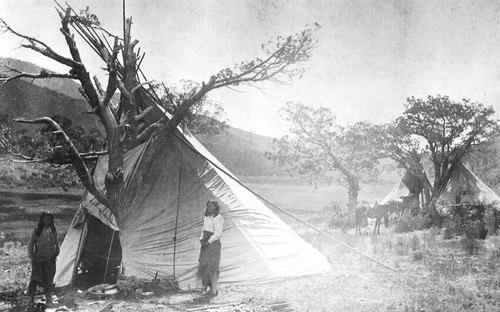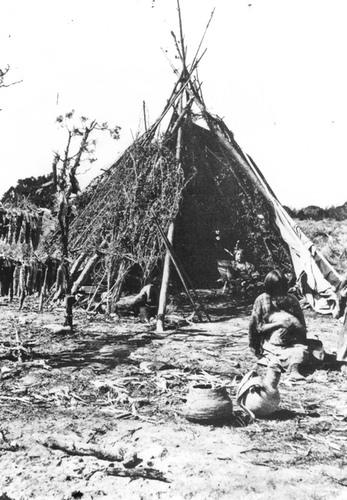Michael Stearly / USDA
Source - http://blogs.usda.gov/2015/01/09/archaeological-heritage-of-colorados-ute-tribe-part-of-national-forests-history-in-rocky-mountain-region/

Wickiups, conical-shape dwellings used by the Ute Mountain Ute Tribe of southwestern Colorado, are still in use for ceremonial purposes. This photo shows a leaner Ute tipi from the 1870-1880s. The U.S. Forest Service’s Rocky Mountain Region partnered with the Dominguez Archaeological Research Group as part of the Region’s mission focus on historic and cultural preservation goals. (Photo courtesy of Curtis Martin, Dominguez Archaeological Research Group)
There are small piles of fallen wooden timbers on national forests in the Rocky Mountain Region that tell a story of the area’s past. They are part of aboriginal wooden structures known as wickiups, a conical-shaped dwelling used by native people.
These relics are known to be part of the Ute Mountain Ute Tribe of southwestern Colorado and are still in use for ceremonial purposes. The relics are part of the tribe’s legacy of living on these lands and are a part of the cultural history on the Grand Mesa – Uncompahgre – Gunnison, San Juan, White River and Rio Grande national forests.
“Part of the Forest Service mission includes interpretive services, which includes sharing with the public how these lands have been used by those who came before us,” said Brian Ferebee, deputy regional forester for the Rocky Mountain Region. “Wickiups and other aboriginal wooden features, such as tree platforms and brush fences, were once commonplace in Colorado. Few examples are still in existence; the majority of the remaining features can be associated with Ute culture and consequently represent the only surviving architecture of the state’s living indigenous peoples.”
Since 2003, the Forest Service has participated in the Colorado Wickiup Project to document historic aboriginal wooden structures in the state. The project is managed by the Dominguez Archaeological Research Group in partnership with the Ute Indian Tribe of northeastern Utah, Southern Ute and Ute Mountain Ute tribes of southwestern Colorado, and other public land management agencies and supported by state funding.

The remains of a free-standing wickiup is inspected in Mesa County, Colorado. Wickiups were used by the Ute Mountain Ute Tribe of southwestern Colorado and are still in use for ceremonial purposes. (Photo courtesy Dominguez Archaeological Research Group)
Researchers for the Wickiup Project have found the remnants of hundreds of such features in locations from Rocky Mountain National Park to the Uncompahgre Plateau, to the Colorado River Basin and Piceance Creek area. The research combines archaeology, ethnography, history and technological innovation and helps to explain how aboriginal peoples of this region used these ephemeral wooden structures in the past. Frequently, metal and stone artifacts are also located at the sites that range in age from less than 100 years to more than 200 years.
“We study the historic records of native peoples and use this to examine the archaeological documentation of abandoned habitations and campsites,” said Molly Westby, the Rocky Mountain Region Heritage Program leader. “What we find helps us to manage these resources as part of our historic and cultural resource preservation goals.”
The research group sought the perspective of the Ute, who see wickiups as a link to their heritage. The project has revealed new aspects about the traditional life ways of the Ute and demonstrates the extensive range of Ute occupation in Colorado.
The Forest Service received the 2014 Steven H. Hart and Governor’s Award for Historic Preservation for work conducted in partnership on the Colorado Wickiup Project. The award recognizes outstanding projects in archaeology and historic preservation in the state.

Wickiups, conical-shape dwellings used by the Ute Mountain Ute Tribe of southwestern Colorado, are still in use for ceremonial purposes. The U.S. Forest Service’s Rocky Mountain Region partnered with the Dominguez Archaeological Research Group as part of the Region’s mission focus on historic and cultural preservation goals. (Photo courtesy Curtis Martin, Dominguez Archaeological Research Group) -